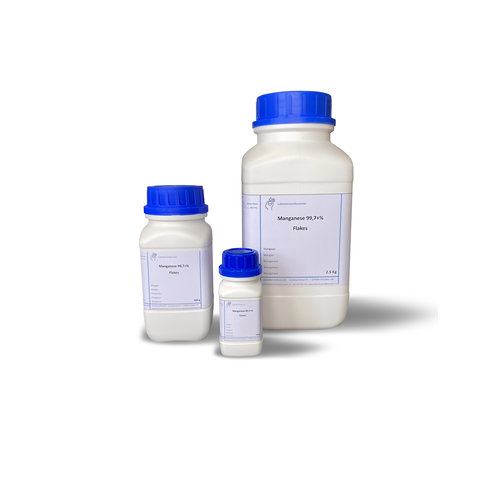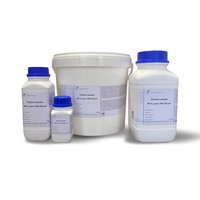You have no items in your shopping cart
Manganese flakes 99,98 %
- Buy 2 and save 5%
- Buy 6 and save 10%
Manganese is a chemical element with the elemental symbol Mn and the atomic number 25. In the periodic table, it is in the 7th subgroup (7th IUPAC group), the manganese group. Manganese is a silvery white, hard, very brittle transition metal, resembling iron in some properties.
Manganese occurs naturally as brownstone and is broken down in large quantities. 90% of the manganese extracted is used in the steel industry in the form of ferro-manganese as an alloying component of steel. It removes oxygen and sulfur from the steel while improving the hardening process. Manganese (IV) oxide, which is used as a cathode in alkaline manganese batteries, is also economically important.
The element is of great biological importance as a component of several enzymes. It operates at a central point in the photosynthesis cycle, where a manganese-calcium cluster is responsible for the oxidation of water to oxygen.
Pure manganese is only used to a very limited extent. 90% of the manganese extracted is used as ferromanganese, mirror iron or silicon manganese in the steel industry. Because manganese forms very stable manganese-oxygen compounds, it has a deoxidizing effect like aluminum and silicon and enhances the action of these elements. In addition, it prevents the formation of the easy-melting iron sulfide and thus has a desulfurization effect. At the same time, the solubility of nitrogen in the steel is increased, which promotes the formation of austenite. This is important for many stainless steels. Another important property of manganese in steel is that it increases the hardenability of the steel.
Manganese is also used in alloys with non-ferrous metals, especially copper alloys and aluminum-manganese alloys. It increases the strength, corrosion resistance and toughness of the metal. The alloy Manganine (83% copper, 12% manganese and 5% nickel), comparable to constantan or - even better - Isaohm, has a low electrical temperature coefficient, i. H. the electrical resistance is only slightly dependent on the temperature. These materials are therefore widely used in electrical measuring equipment.
Manganese is also used as an activator in phosphorescence. According to current knowledge, the wavelength of the emitted light is between 450 and 750 nm (Mn2+) or 620 and 730 nm (Mn4+), depending on the oxidation level. BaMgAl10O17: Eu2+, Mn2+ (green emitter), and Mg14Ge5O24: Mn4+ (red emitter) are of particular practical importance as phosphors in white LEDs.
YInMn blue is a mixed oxide of yttrium, indium and manganese oxides, which exhibits a very pure and brilliant blue.
Pure manganese is produced on the order of about 140,000 tons per year. It is widely used for the production of special steels and aluminum alloys. It is also used to make zinc-manganese ferrites for electronic components.
Technical data:
Manganese Dioxide
Empirical formula MnO2
Molar mass (M) 86.94 g/mol
Density (D) 5.08 g/cm
Melting point (mp) 535°C
WCS 1
CAS no. [1313-13-9]
EC-No. 215-202-6









